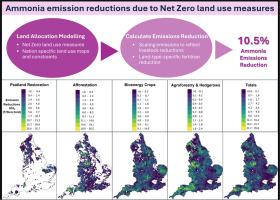土地利用变化对氨排放的净零影响:英国空间制图案例研究
Q2 Environmental Science
引用次数: 0
摘要
全球各地正在制定应对气候变化的土地利用措施,其影响将超出其净零目标。最适合实施这些措施的土地可能是农业用地,这意味着这些措施的实施将影响氨的排放,并对健康、生态系统和粮食生产产生后续影响。现有的氨排放模型没有考虑到全国范围内土地使用净零目标的空间分布情况,这意味着这些后续影响可能无法得到充分评估。以英国为案例研究区,我们采用空间土地分配(LA)模型将这些措施应用于合适的土地。然后,我们使用排放模型来估计牲畜和化肥氨排放在5公里网格分辨率下的变化。为了评估LA模型对结果的影响,我们还进行了非土地分配(NLA)模型,该模型不考虑土地的适宜性,而是在所有农业用地上均匀分布措施。由于LA建模的措施,最终减少的总排放量为15.9 kt-NH3,或英国牲畜和化肥排放总量的10.5%。NLA方法产生了类似的总减少量,但其分布明显不同,特别是在泥炭地恢复和造林措施方面。我们的结论是,需要对净零土地利用措施进行空间土地分配建模,以便为政策和战略提供信息,以确保找到合适的土地,并考虑到更广泛的环境和健康影响。本文章由计算机程序翻译,如有差异,请以英文原文为准。

Net Zero land-use change impact on ammonia emissions: a spatial mapping case study in England
Land-use measures to tackle climate change are being established across the globe that will have implications beyond their net-zero objectives. The most suitable land for these measures is likely to be in agricultural use which means their implementation will affect ammonia emissions and have onward impacts on health, ecosystems and food production. Existing ammonia emissions modelling does not consider how national scale net zero land-use targets are spatially distributed which means these onward impacts may not be adequately assessed. Using England as a case study area, we employed spatial land allocation (LA) modelling to apply these measures on suitable land. We then used emissions modelling to estimate the resulting changes to livestock and chemical fertiliser ammonia emissions at a 5 km grid resolution. To assess the effect of LA modelling on results, we also carried out non-land allocation (NLA) modelling which did not consider the suitability of land, instead distributing the measures uniformly across all agricultural land. The resulting total reductions due to LA modelling of measures was 15.9 kt-NH3, or 10.5 % of total livestock and chemical fertiliser emissions in England. The NLA approach resulted in similar total reductions, but their distribution was markedly different, particularly for peatland restoration and afforestation measures. We conclude that spatial land allocation modelling of net zero land-use measures is needed to inform policies and strategies to ensure suitable land is targeted and wider environmental and health impacts are considered.
求助全文
通过发布文献求助,成功后即可免费获取论文全文。
去求助
来源期刊

Environmental Advances
Environmental Science-Environmental Science (miscellaneous)
CiteScore
7.30
自引率
0.00%
发文量
165
审稿时长
12 weeks
期刊介绍:
 求助内容:
求助内容: 应助结果提醒方式:
应助结果提醒方式:


